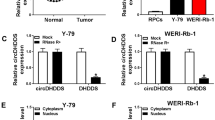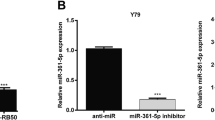Abstract
Retinoblastoma (RB) is a malignant intraocular tumor that frequently occurs in infants and toddlers. Although the most of RB patients in the developed countries could survival from this cancer, the patients in undeveloped areas are still suffering. The human retinal pigment epithelial cell line ARPE-19 and human retinoblastoma (RB) cell lines HXO-RB44, Y79, and WERI-Rb1 were cultured. The mRNA levels of BANCR and miR-204-3p in these cell lines were measured by qRT-PCR. After transfection with sh-BANCR or treatment with miR-204-3p inhibitor in Y79 cells, the cell proliferation rate, growth, invasion, migration, apoptosis and Wnt/β-catenin signaling pathway activity were measured. The regular Y79 and Y79 cells stably expressed sh-BANCR were injected subcutaneously into nude mice, respectively. The volumes and pathohistological futures of tumors were compared. The biochemical features similar to the cell culture were detected and compered. The mRNA measurements showed that BANCR negatively modulate miR-204-3p expression via directly integration with it. Besides, miR-204-3p and Wnt/β-catenin signalling pathway were found to participate in the oncogenic effects of BANCR on RB cell line by Hoechst staining, cell Counting Kit-8 (CCK-8) assay, wound healing assay, transwell assay, and Western blot analysis in vitro. In addition, an in vivo tumorigenesis experiment in nude mice injected with Y79 cells stably expressed sh-BANCR conformed in the effects of BANCR on RB. Taken together, the knockdown of BANCR inhibited cell proliferation, apoptosis, invasion, and migration in RB via targeting miR-204-3p, the mechanism may involve inhibiting Wnt/β-catenin signaling pathway.






Similar content being viewed by others
References
Mendoza PR, Grossniklaus HE (2015) The biology of retinoblastoma. Prog Mol Biol Transl Sci 134:503–516. https://doi.org/10.1016/bs.pmbts.2015.06.012
Rodriguez-Galindo C, Orbach DB, VanderVeen D (2015) Retinoblastoma. Pediatr Clin N Am 62:201–223. https://doi.org/10.1016/j.pcl.2014.09.014
Fabian ID, Onadim Z, Karaa E, Duncan C, Chowdhury T, Scheimberg I, Ohnuma SI, Reddy MA, Sagoo MS (2018) The management of retinoblastoma. Oncogene 37:1551–1560. https://doi.org/10.1038/s41388-017-0050-x
Metz KA, Westerwick D, Driever F, Schmid KW, Le Guin CHD (2017) Retinoblastoma and retinocytoma (retinoma). Pathologe 38:507–514. https://doi.org/10.1007/s00292-017-0384-8
Kivela TT, Hadjistilianou T (2017) Neonatal Retinoblastoma. Asia Pac J Oncol Nurs 4:197–204. https://doi.org/10.4103/apjon.apjon_18_17
Manjandavida FP, Honavar SG, Shields CL, Shields JA (2013) Retinoblastoma: recent update and management Frontiers. Asia Pac J Ophthalmol (Phila) 2:351–353. https://doi.org/10.1097/APO.0000000000000026
Lin P, O'Brien JM (2009) Frontiers in the management of retinoblastoma. Am J Ophthalmol 148:192–198. https://doi.org/10.1016/j.ajo.2009.04.004
Jabbour P, Chalouhi N, Tjoumakaris S, Gonzalez LF, Dumont AS, Chitale R, Rosenwasser R, Bianciotto CG, Shields C (2012) Pearls and pitfalls of intraarterial chemotherapy for retinoblastoma. J Neurosurg Pediatr 10:175–181. https://doi.org/10.3171/2012.5.PEDS1277
Gatta G, Capocaccia R, Stiller C, Kaatsch P, Berrino F, Terenziani M, EUROCARE Working Group (2005) Childhood cancer survival trends in Europe: a EUROCARE working group study. J Clin Oncol 23:3742–3751. https://doi.org/10.1200/JCO.2005.00.554
Lanzafame M, Bianco G, Terracciano LM, Ng CKY, Piscuoglio S (2018) The role of long non-coding RNAs in Hepatocarcinogenesis. Int J Mol Sci 19. https://doi.org/10.3390/ijms19030682
Clark RJ, Craig MP, Agrawal S, Kadakia M (2018) microRNA involvement in the onset and progression of Barrett's esophagus: a systematic review. Oncotarget 9:8179–8196. https://doi.org/10.18632/oncotarget.24145
Zhou S, Wang L, Yang Q, Liu H, Meng Q, Jiang L, Wang S, Jiang W (2018) Systematical analysis of lncRNA-mRNA competing endogenous RNA network in breast cancer subtypes. Breast Cancer Res Treat 169:267–275. https://doi.org/10.1007/s10549-018-4678-1
Koleckova M, Janikova M, Kolar Z (2018) MicroRNAs in triple-negative breast cancer. Neoplasma 65:1–13. https://doi.org/10.4149/neo_2018_170115N36
Momen-Heravi F, Bala S (2018) Emerging role of non-coding RNA in oral cancer. Cell Signal 42:134–143. https://doi.org/10.1016/j.cellsig.2017.10.009
Li H, Chen S, Liu J, Guo X, Xiang X, Dong T, Ran P, Li Q, Zhu B, Zhang X, Wang D, Xiao C, Zheng S (2018) Long non-coding RNA PVT1-5 promotes cell proliferation by regulating miR-126/SLC7A5 axis in lung cancer. Biochem Biophys Res Commun 495:2350–2355. https://doi.org/10.1016/j.bbrc.2017.12.114
Zhang M, Li Q, Pan Y, Wang H, Liu G, Yin H (2018) MicroRNA-655 attenuates the malignant biological behaviours of retinoblastoma cells by directly targeting PAX6 and suppressing the ERK and p38 MAPK signalling pathways. Oncol Rep 39:2040–2050. https://doi.org/10.3892/or.2018.6264
Wu X, Zeng Y, Wu S, Zhong J, Wang Y, Xu J (2015) MiR-204, down-regulated in retinoblastoma, regulates proliferation and invasion of human retinoblastoma cells by targeting CyclinD2 and MMP-9. FEBS Lett 589:645–650. https://doi.org/10.1016/j.febslet.2015.01.030
Su S, Gao J, Wang T, Wang J, Li H, Wang Z (2015) Long non-coding RNA BANCR regulates growth and metastasis and is associated with poor prognosis in retinoblastoma. Tumour Biol 36:7205–7211. https://doi.org/10.1007/s13277-015-3413-3
Livak KJ, Schmittgen TD (2001) Analysis of relative gene expression data using real-time quantitative PCR and the 2(−Delta Delta C(T)) method. Methods (San Diego, Calif.) 25:402–408. https://doi.org/10.1006/meth.2001.1262
Rion N, Ruegg MA (2017) LncRNA-encoded peptides: more than translational noise? Cell Res 27:604–605. https://doi.org/10.1038/cr.2017.35
Dey BK, Mueller AC, Dutta A (2014) Long non-coding RNAs as emerging regulators of differentiation, development, and disease. Transcription 5:e944014. https://doi.org/10.4161/21541272.2014.944014
Deng H, Zhang J, Shi J, Guo Z, He C, Ding L, Tang JH, Hou Y (2016) Role of long non-coding RNA in tumor drug resistance. Tumour Biol 37:11623–11631. https://doi.org/10.1007/s13277-016-5125-8
Vikram R, Ramachandran R, Abdul KS (2014) Functional significance of long non-coding RNAs in breast cancer. Breast Cancer 21:515–521. https://doi.org/10.1007/s12282-014-0554-y
Osielska MA, Jagodzinski PP (2018) Long non-coding RNA as potential biomarkers in non-small-cell lung cancer: what do we know so far? Biomed Pharmacother 101:322–333. https://doi.org/10.1016/j.biopha.2018.02.099
Zhuang J, He S, Wang G, Wang G, Ni J, Zhang S, Ye Y, Xia W (2018) Long non-coding RNA FGFR3-AS1 promotes hepatocellular carcinoma carcinogenesis via modulating PI3K/AKT pathway. Oncol Res 26:1257–1265. https://doi.org/10.3727/096504018X15172756878992
Peng Z, Liu C, Wu M (2018) New insights into long noncoding RNAs and their roles in glioma. Mol Cancer 17:61. https://doi.org/10.1186/s12943-018-0812-2
Flockhart RJ, Webster DE, Qu K, Mascarenhas N, Kovalski J, Kretz M, Khavari PA (2012) BRAFV600E remodels the melanocyte transcriptome and induces BANCR to regulate melanoma cell migration. Genome Res 22:1006–1014. https://doi.org/10.1101/gr.140061.112
Liu XF, Hao JL, Xie T, Pant OP, Lu CB, Lu CW, Zhou DD (2018) The BRAF activated non-coding RNA: a pivotal long non-coding RNA in human malignancies. Cell Prolif 51:e12449. https://doi.org/10.1111/cpr.12449
Shen X, Bai Y, Luo B, Zhou X (2017) Upregulation of lncRNA BANCR associated with the lymph node metastasis and poor prognosis in colorectal cancer. Biol Res 50:32. https://doi.org/10.1186/s40659-017-0136-5
Liao T, Qu N, Shi RL, Guo K, Ma B, Cao YM, Xiang J, Lu ZW, Zhu YX, Li DS, Ji QH (2017) BRAF-activated LncRNA functions as a tumor suppressor in papillary thyroid cancer. Oncotarget 8:238–247. https://doi.org/10.18632/oncotarget.10825
Liu A, Liu S (2016) Noncoding RNAs in growth and death of Cancer cells. Adv Exp Med Biol 927:137–172. https://doi.org/10.1007/978-981-10-1498-7_5 Review
Khorshidi A, Dhaliwal P, Yang BB (2016) Noncoding RNAs in tumor angiogenesis. Adv Exp Med Biol 927:217–241. https://doi.org/10.1007/978-981-10-1498-7_8
Slattery ML, Mullany LE, Sakoda LC, Samowitz WS, Wolff RK, Stevens JR, Herrick JS (2018) Expression of Wnt-signaling pathway genes and their associations with miRNAs in colorectal cancer. Oncotarget 9:6075–6085. https://doi.org/10.18632/oncotarget.23636
Wei H, Zhang JJ, Tang QL (2017) MiR-638 inhibits cervical cancer metastasis through Wnt/beta-catenin signaling pathway and correlates with prognosis of cervical cancer patients. Eur Rev Med Pharmacol Sci 21:5587–5593. https://doi.org/10.26355/eurrev_201712_13999
Huang J, He Y, McLeod HL, Xie Y, Xiao D, Hu H, Chen P, Shen L, Zeng S, Yin X, Ge J, Li L, Tang L, Ma J, Chen Z (2017) miR-302b inhibits tumorigenesis by targeting EphA2 via Wnt/ beta-catenin/EMT signaling cascade in gastric cancer. BMC Cancer 17:886. https://doi.org/10.1186/s12885-017-3875-3
Krishnamurthy N, Kurzrock R (2018) Targeting the Wnt/beta-catenin pathway in cancer: update on effectors and inhibitors. Cancer Treat Rev 62:50–60. https://doi.org/10.1016/j.ctrv.2017.11.002
Majidinia M, Aghazadeh J, Jahanban-Esfahlani R, Yousefi B (2018) The roles of Wnt/beta-catenin pathway in tissue development and regenerative medicine. J Cell Physiol 233:5598–5612. https://doi.org/10.1002/jcp.26265
Peng Y, Zhang X, Feng X, Fan X, Jin Z (2017) The crosstalk between microRNAs and the Wnt/beta-catenin signaling pathway in cancer. Oncotarget 8:14089–14106. https://doi.org/10.18632/oncotarget.12923
Onyido EK, Sweeney E, Nateri AS (2016) Wnt-signalling pathways and microRNAs network in carcinogenesis: experimental and bioinformatics approaches. Mol Cancer 15:56. https://doi.org/10.1186/s12943-016-0541-3
Zhang K, Zhang J, Han L, Pu P, Kang C (2012) Wnt/beta-catenin signaling in glioma. J NeuroImmune Pharmacol 7:740–749. https://doi.org/10.1007/s11481-012-9359-y
He H, Chen K, Wang F, Zhao L, Wan X, Wang L, Mo Z (2015) miR-204-5p promotes the adipogenic differentiation of human adipose-derived mesenchymal stem cells by modulating DVL3 expression and suppressing Wnt/beta-catenin signaling. Int J Mol Med 35:1587–1595. https://doi.org/10.3892/ijmm.2015.2160
Wang L, Tian H, Yuan J, Wu H, Wu J, Zhu X (2015) CONSORT: Sam68 is directly regulated by MiR-204 and promotes the self-renewal potential of breast Cancer cells by activating the Wnt/Beta-catenin signaling pathway. Medicine (Baltimore) 94:e2228. https://doi.org/10.1097/MD.0000000000002228
Zou Y, Li J, Chen Y, Xiao H, Zhang F, Yu D, Luo K (2017) BANCR: a novel oncogenic long non-coding RNA in human cancers. Oncotarget 8:94997–95004. https://doi.org/10.18632/oncotarget.22031
Acknowledgements
The authors would like to thank the members of The Second Clinical Medical College of Qingdao University, for providing helpful discussions and technical support concerning the present study.
Author information
Authors and Affiliations
Corresponding author
Ethics declarations
Competing Interests
The authors declare that they have no competing interests.
Additional information
Publisher’s Note
Springer Nature remains neutral with regard to jurisdictional claims in published maps and institutional affiliations.
Rights and permissions
About this article
Cite this article
Sun, QX., Wang, RR., Liu, N. et al. Dysregulation of miR-204-3p Driven by the Viability and Motility of Retinoblastoma via Wnt/β-catenin Pathway In Vitro and In Vivo. Pathol. Oncol. Res. 26, 1549–1558 (2020). https://doi.org/10.1007/s12253-019-00722-0
Received:
Accepted:
Published:
Issue Date:
DOI: https://doi.org/10.1007/s12253-019-00722-0




